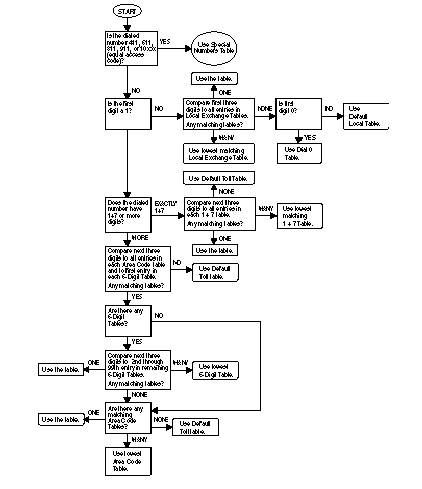
ARS Table Selection
Table Selection
411, 611, 811, 911, or 10xx/101xxxxx (Equal Access Codes)
If the caller dials one of these N11 or equal access (Interexchange or IXC) numbers, the call is routed over the main pool, using the factory-set Special Numbers (N11) Table.
|
Area Code Tables |
Local Exchange Tables |
6-Digit Tables |
1+7 Tables |
|
Dial 0 Table |
Special No. (N11) Table |
Default Toll Table |
Default Local Table |
First Digit Not a 1, N11, or Equal Access Code
All but the Local Exchange, Default Local, and Dial 0 Tables are eliminated.
|
Area Code Tables |
Local Exchange Tables |
6-Digit Tables |
1+7 Tables |
|
Dial 0 Table |
Special No. (N11) Table |
Default Toll Table |
Default Local Table |
Next, ARS examines the entries in the Local Exchange Tables:
First Digit a 1 (Not an Equal Access Code)
ARS eliminates the Default Local, Dial 0, Special Number, and Local Exchange Tables and proceeds as described below.
|
Area Code Tables |
Local Exchange Tables |
6-Digit Tables |
1+7 Tables |
|
Dial 0 Table |
Special No. (N11) Table |
Default Toll Table |
Default Local Table |
If only a "1" followed by seven digits have been dialed and there is one 1+7 Table that matches, it is chosen. If more than one table matches, the lowest-numbered table is chosen. If there are no 1+7 Tables that match, ARS picks the Default Toll Table.
If more than seven digits have been dialed after the 1, the 1+7 Tables are eliminated. The next three digits following the 1 are compared to the 3-digit area codes in the Area Code Tables and the first three digits of the 6-Digit Tables; any unmatching tables are eliminated. If there are no matches, the Default Toll Table is selected.
If there are matching tables, the next three digits are compared to the second through ninety-ninth entry in the remaining 6-Digit Tables. If there is only one match, that 6-Digit Table is used. If there is more than one match, the lowest 6-Digit Table is used. If there are no matches and there are no Area Code Tables left, the Default Toll Table is selected. If there are no matches and there are Area Code Tables that have not been eliminated, one of the Area Code Tables is chosen. If there is one table left, it is used. If there is more than one table, the lowest one is used.
Figure 1 is a flowchart that shows how a table is selected.

ARS Table Selection